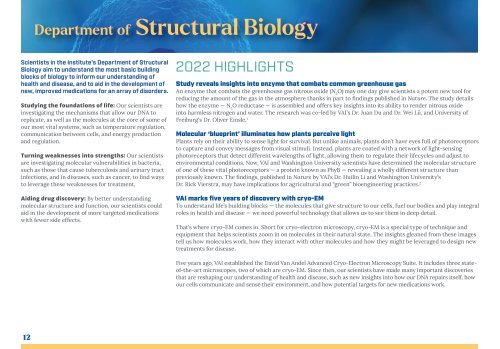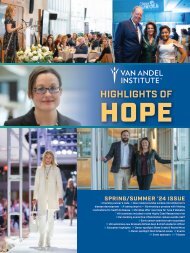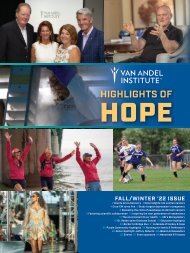2022 Annual Report
This is the 2022 Annual Report for Van Andel Institute.
This is the 2022 Annual Report for Van Andel Institute.
Create successful ePaper yourself
Turn your PDF publications into a flip-book with our unique Google optimized e-Paper software.
Department of Structural Biology<br />
Scientists in the Institute’s Department of Structural<br />
Biology aim to understand the most basic building<br />
blocks of biology to inform our understanding of<br />
health and disease, and to aid in the development of<br />
new, improved medications for an array of disorders.<br />
Studying the foundations of life: Our scientists are<br />
investigating the mechanisms that allow our DNA to<br />
replicate, as well as the molecules at the core of some of<br />
our most vital systems, such as temperature regulation,<br />
communication between cells, and energy production<br />
and regulation.<br />
Turning weaknesses into strengths: Our scientists<br />
are investigating molecular vulnerabilities in bacteria,<br />
such as those that cause tuberculosis and urinary tract<br />
infections, and in diseases, such as cancer, to find ways<br />
to leverage these weaknesses for treatment.<br />
Aiding drug discovery: By better understanding<br />
molecular structure and function, our scientists could<br />
aid in the development of more targeted medications<br />
with fewer side effects.<br />
<strong>2022</strong> HIGHLIGHTS<br />
Study reveals insights into enzyme that combats common greenhouse gas<br />
An enzyme that combats the greenhouse gas nitrous oxide (N 2<br />
O) may one day give scientists a potent new tool for<br />
reducing the amount of the gas in the atmosphere thanks in part to findings published in Nature. The study details<br />
how the enzyme — N 2<br />
O reductase — is assembled and offers key insights into its ability to render nitrous oxide<br />
into harmless nitrogen and water. The research was co-led by VAI's Dr. Juan Du and Dr. Wei Lü, and University of<br />
Freiburg's Dr. Oliver Einsle. 1<br />
Molecular ‘blueprint’ illuminates how plants perceive light<br />
Plants rely on their ability to sense light for survival. But unlike animals, plants don’t have eyes full of photoreceptors<br />
to capture and convey messages from visual stimuli. Instead, plants are coated with a network of light-sensing<br />
photoreceptors that detect different wavelengths of light, allowing them to regulate their lifecycles and adjust to<br />
environmental conditions. Now, VAI and Washington University scientists have determined the molecular structure<br />
of one of these vital photoreceptors — a protein known as PhyB — revealing a wholly different structure than<br />
previously known. The findings, published in Nature by VAI’s Dr. Huilin Li and Washington University’s<br />
Dr. Rick Vierstra, may have implications for agricultural and “green” bioengineering practices. 2<br />
VAI marks five years of discovery with cryo-EM<br />
To understand life’s building blocks — the molecules that give structure to our cells, fuel our bodies and play integral<br />
roles in health and disease — we need powerful technology that allows us to see them in deep detail.<br />
That’s where cryo-EM comes in. Short for cryo-electron microscopy, cryo-EM is a special type of technique and<br />
equipment that helps scientists zoom in on molecules in their natural state. The insights gleaned from these images<br />
tell us how molecules work, how they interact with other molecules and how they might be leveraged to design new<br />
treatments for disease.<br />
Five years ago, VAI established the David Van Andel Advanced Cryo-Electron Microscopy Suite. It includes three stateof-the-art<br />
microscopes, two of which are cryo-EM. Since then, our scientists have made many important discoveries<br />
that are reshaping our understanding of health and disease, such as new insights into how our DNA repairs itself, how<br />
our cells communicate and sense their environment, and how potential targets for new medications work.<br />
12
















